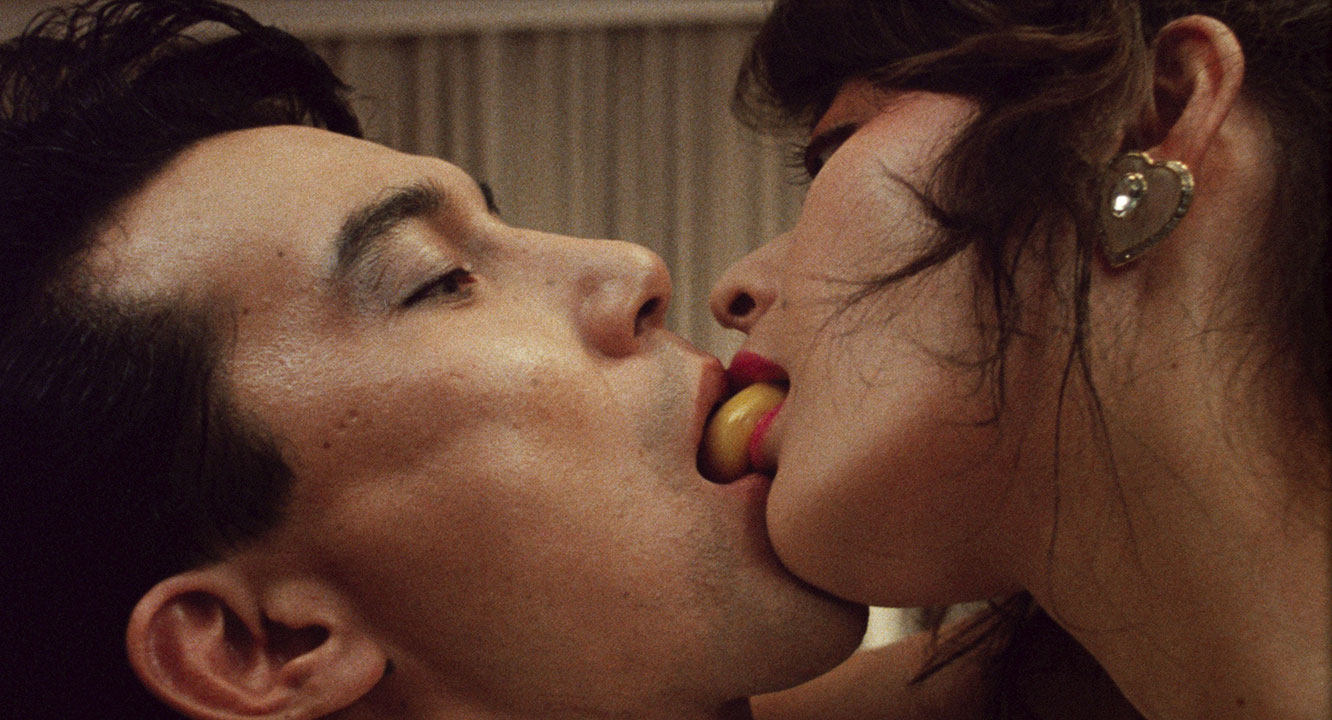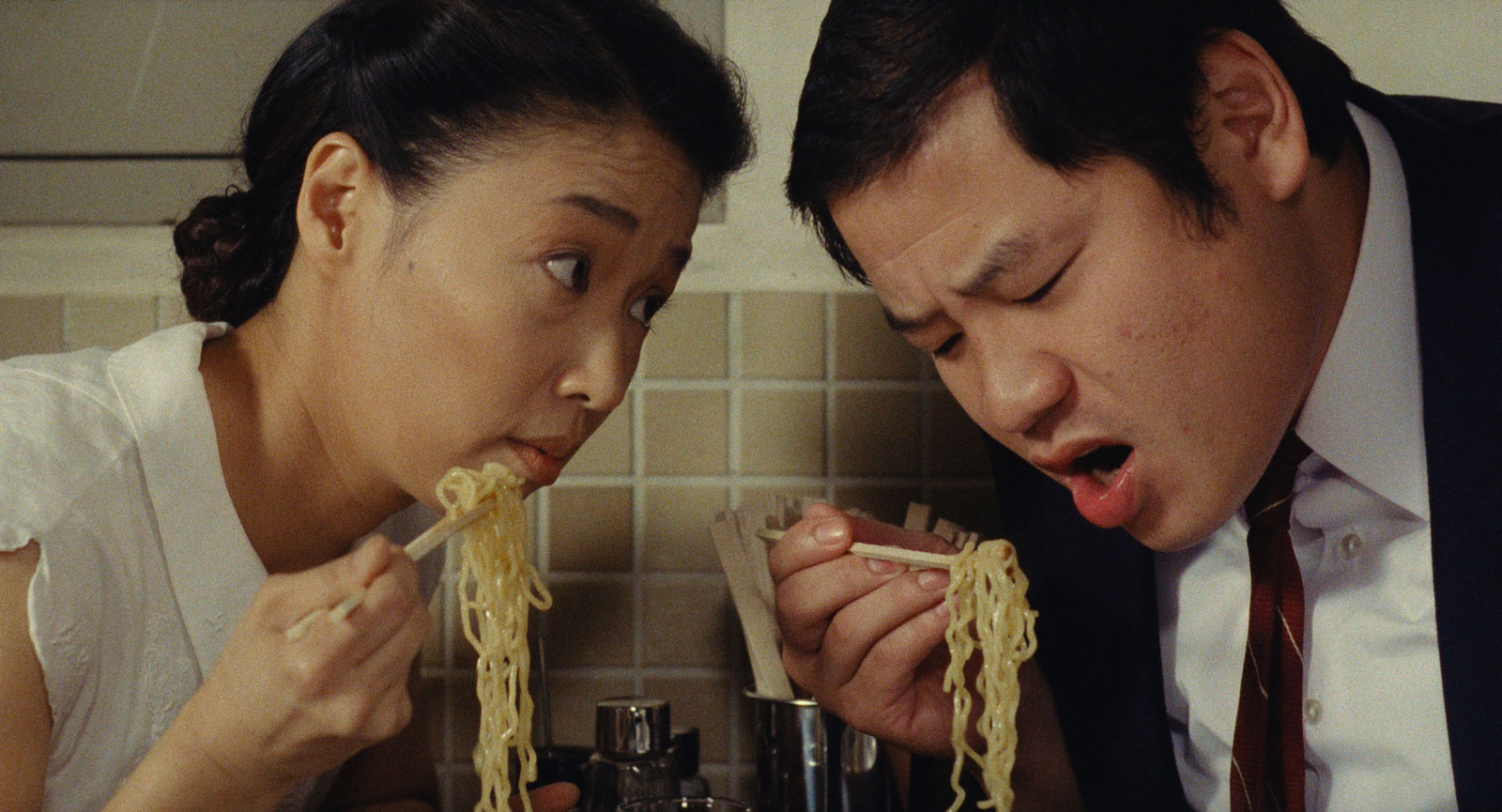Three years ago, a foodie friend recommended the 1985 Japanese film Tampopo, a self-styled “ramen western.” I wasn’t a foodie and I didn’t much care for ramen, so I ignored him. Now dinner has become the thrilling climax of every locked-down day, and my most sensual aesthetic encounters come from the watermelon radishes and candy cane beets that I buy at the farmer’s market. This weekend, I realized that the time had come for me to watch Tampopo—after dinner, of course.
At the beginning of the film, a laconic trucker named Gorō, a Robert Mitchum type in a plaid shirt and cowboy hat, stops for a bite at a dingy roadside ramen shop. He soon finds that the proprietress, Tampopo, is in need of help: her customers are drunks and her ramen is no good. Gorō provokes a belligerent regular by lobbing a slice of naruto, a scalloped white round of fish paste with a candy-pink swirl, at him (the ramen shop equivalent of a pie in the face). Gorō loses that fight, but in the process he wins the trust of the charming, beleaguered Tampopo. When he tells her that her noodles have no pizzazz, she begs him to be her teacher.
There’s a lot going on in this film: satire of the Japanese craze for European-style fine dining, comic reappropriation of American Westerns and Kurosawa, criticism of the relegation of women to the least prestigious kinds of cooking. In one of the movie’s many surreal interludes, a dying woman rises from her sickbed to cook one last dinner before expiring. In scenes of what might be termed “ramansplaining,” panels of self-appointed male experts hector a frazzled Tampopo about the proper methods of broth boiling and pork slicing. But in our own moment when the lower half of the face has gone into hiding, its display a new taboo in public spaces, what stands out most of all is Tampopo’s celebration of mouths—often engaged in just the sorts of activities we aren’t allowed these days.
In his effort to teach Tampopo how to make better ramen, Gorō takes her on a tour of rival restaurants. They elbow their way into cramped, steamy spaces in which flocks of happy people are hoovering up noodles, gulping fearlessly from bowls that are pushed casually back once they’re empty. Not even the cooks wear gloves: this is a world without germophobia. Tampopo tricks one chef into divulging his recipe by complaining that the noodles she’s been served are subpar: he frowns, takes her chopsticks, and samples a noodle from her bowl, biting it and letting the other half fall back into the broth before handing the bowl back to her. As they work on finding the perfect ramen, the dauntless Gorō and Tampopo taste noodles from a box that’s just been discarded in front of a restaurant. I shivered with excitement.
The film takes great pleasure in amplifying and embellishing the sounds of people eating: the clank of plates, the rattle of ice, the crunch of curry puffs. Noodles make a magical ping as they disappear into eager mouths. At a European-style hotel restaurant, girls listen as their glamorous, lamé-clad teacher instructs them in the art of silent spaghetti eating. “Even the slightest sound is absolutely taboo abroad!” she warns them. But a spaghetti-slurping European at another table seems to say otherwise. The hungry girls follow his lead. Soon even the teacher is enjoying her spaghetti alle vongole with noisy abandon.
Eating is obviously erotic, and the film casts the mouth as the principal sexual organ. In one subplot, a gangster in a white waistcoat has ordered room service. The waiter has hardly made it out the door before the gangster has sprinkled salt and squeezed lemon on his moll’s nipple, licking it off. She dips her breast in a bowl of whipped cream and lowers it to his waiting lips. They pass an egg yolk back and forth between their mouths until it breaks, dripping down the woman’s chin and onto her white lace dress and his cream linen jacket. She faints in ecstasy.
Under normal circumstances, this scene would have been the most titillating moment in the film. But anyone with lemons, eggs, and an in-house lover can reenact it; today, a restaurant is far more exciting than a bedroom. In one of the raciest vignettes, a man buys and eats fresh dumplings on a train, intermittently palpitating his sore gums with his fingers. He’s on his way to the dentist for surgery. Afterwards, he sits in the park licking a soft-serve ice cream cone. When a little boy approaches, he hands the cone over. Soon the boy has plunged his face into the vanilla and chocolate swirls—the ice cream of a stranger! And then there’s a scene where the gangster goes to the beach and asks a young diver for one of the oysters she’s catching. He sucks it straight from the shell, and cuts his mouth. She lets him eat a second oyster out of her hand, and then she licks the blood from his lips. Tampopo’s ode to the oral ends with a shot of a woman breastfeeding on a sunny park bench. As the credits roll, the camera closes in on the blissful face of the firmly latched infant. Suck, slurp, lick, share: these are joys of living.
Advertisement
This is part of “My Quarantine,” a continuing NYR Daily series in which our contributors share how they’re spending their time while social distancing.




